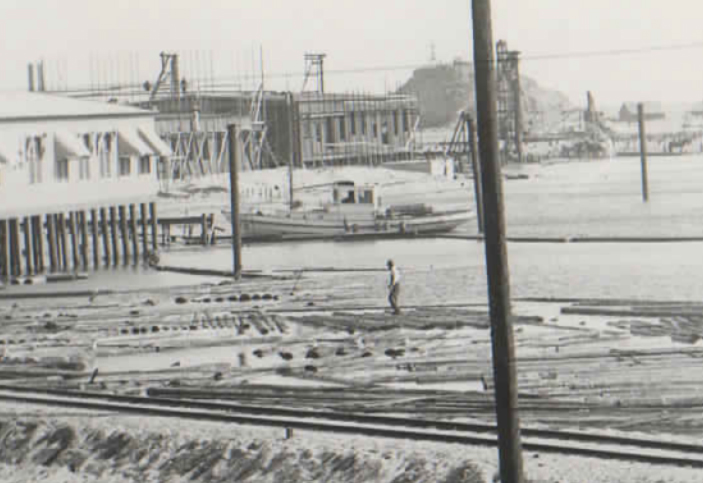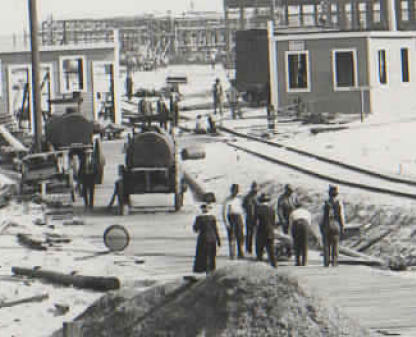Picturing California petroleum history in a family album.
Preserving a family’s photographs from Los Angeles Harbor brought insights into California’s maritime and petroleum heritage — including the 1920s story of Puente Oil Company.
Among many others, a photograph of men working at an oil facility at San Pedro Harbor of Los Angeles preserves the petroleum heritage of the Raynor family. Seeking to share the legacy of her father career at the Los Angeles Harbor Authority, Valerie Raynor contacted the American Oil & Gas Historical Society in 2017 (see AOGHS Oil Families).
The search for a permanent home for Paul Thome’s collection did not take long. His daughter, a longtime resident in the Los Angeles area, decided to donate them to the Los Angeles Maritime Museum after talking with Mary Frances, the museum’s director.
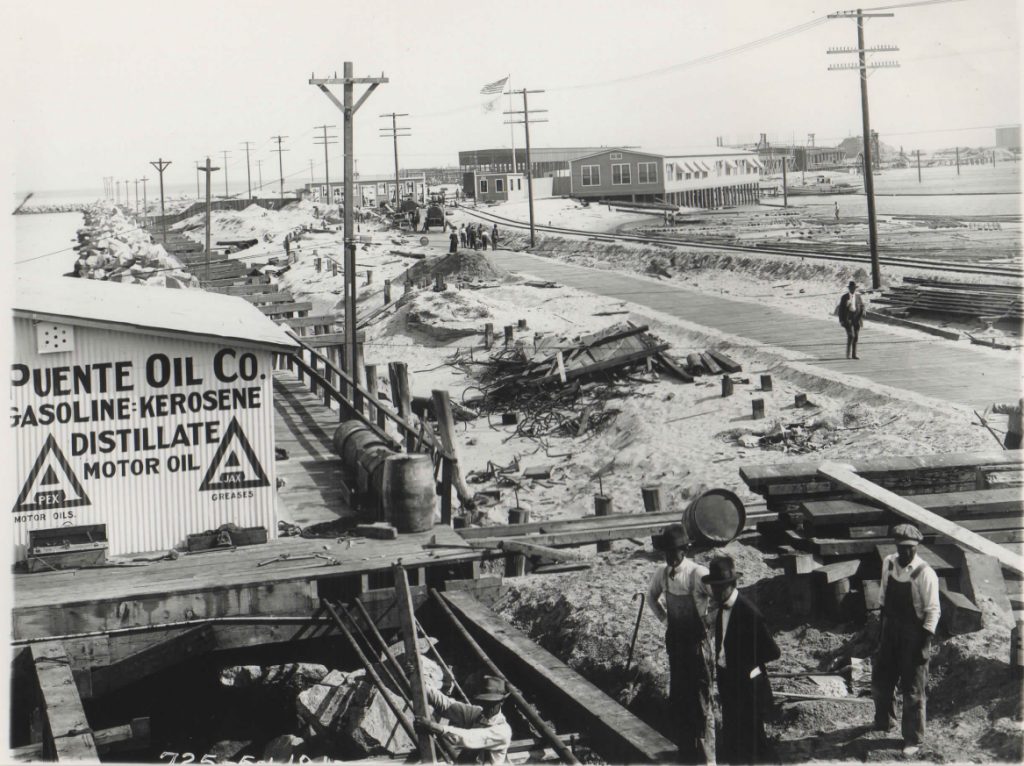
Among the family collection of Paul J. Thome’s photos, much can be learned from this image of a Puente Oil company facility at San Pedro Harbor of Los Angeles. Photo courtesy Valerie Raynor.
“I felt this would be a good place to start with all the pictures,” Raynor explained, adding that In exchange for her donation of the images, which the museum will share with the San Pedro Bay Historical Museum, the Raynor family received high-resolution digital copies.
Raynor said she needed to learn how to scan. “I decided I should not use the excuse of ‘I can’t do this,’ when we tell our kids that that is not a good enough excuse! So, I called a friend who walked me through how to scan and send a pic.” Her family and historians have benefited, thanks to the preservation of her father’s business career.
“It’s a great way to have them preserved for future generations,” Raynor said. “The pictures will be kept in honor of my father, Paul J. Thome, who worked for the City of Los Angeles at the San Pedro Harbor in the 1960s and 1970s.”
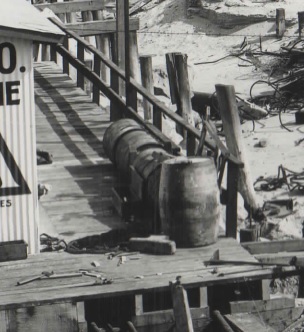
Traditional 42-gallon “bilged” wooden oil barrels from the industry’s earliest days were gradually replaced by the 55-gallon steel drum.
The San Pedro Bay Historical Society was established in 1974 by a group of residents, “seeking ways to preserve the unique harbor area so rich in history and influential in the development of Los Angeles proper, banded together in 1974,” according to SPBHS. A lot of oil history can be learned from the Raynor photo.
Although an 1865 discovery near oil seeps in Humboldt County might be considered the first California oil well, the state’s petroleum exploration industry took off following an 1876 gusher that revealed the Pico Canyon oilfield.
By 1886, William Rowland, son of the owner of Rancho La Puente, John Rowland, and his partner William Lacy had successfully drilled several oil wells on the ranch. The wells helped launch the Puente Oil Company in Los Angeles.
The new company was one of many southern California oil ventures (a small, unsuccessful enterprise with a similar name was Puente Crude Oil Company). About 35 miles south of Pico Canyon, the giant Los Angeles City oilfield was discovered in 1892.
Picturing Puente Oil
A lot of petroleum infrastructure history can be learned from one of Raynor image. In the harbor photograph’s background, horse-drawn tank wagons, railroad tracks, boats, river pigs, laborers, ladies and gentlemen share a changing workplace.
Old and new technologies are seen at the harbor site as well – Nellie Bly’s 55-gallon steel drums and old 42-gallon wooden barrels; the sails and train rails with log drivers (catty men, river rats, river pigs, etc.) corralling floating pilings; and on South Seaside Avenue, the Puente Oil Company – the first to exploit southern California’s Puente Hills’ petroleum resources.
Because of its high gravity, Puente Oil sold for up to $1.75 a barrel, while lesser grades sold at 75 cents to $1 per barrel. The company soon built a pipeline from its drilling sites to the Puente railroad depot. From Puente, tank cars (marked “P. O. Co.”) carried the oil to Los Angeles harbor. The company prospered.
In 1895, a six-year contract to supply substantial quantities of crude oil to the Chino Beet Sugar refinery prompted Puente Oil to build its own pipeline to the user, 16 miles away. Just the first year’s requirement was for 80,000 barrels of oil.
Puente Oil then built its own 800-barrels-a-day crude oil refinery nearby in Chino. This was before the Supreme Court’s 1911 ruling to break up the Standard Oil monopoly, so Standard bought all of the Puente Oil refinery’s output.
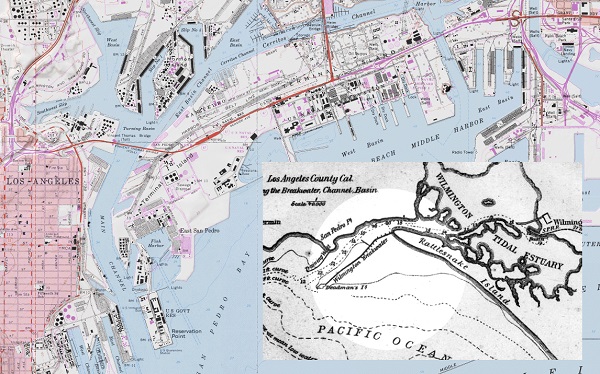
Dead Man’s Island and Rattlesnake Island (both now part of the largely artificial Terminal Island) were first linked in 1893. Modern dredging has changed much of the harbor’s landscape.
By 1900, Puente Oil had grown to “a total of 4,700 acres of the best light oil-producing lands in California” with 85 wells pumping a total of 20,000 barrels of oil a month. Puente Oil in 1903 merged with the Columbia Oil Producing Company (an 1898 venture of W.L. Hardison, co-founder of Union Oil Company).
“The consolidation of the Puente and Columbia companies is with one exception the largest oil deal ever consummated in Southern California, and carries as great an oil value as any deal of record,” noted the Pacific Coast Reporter. Shell Union Oil Company acquired both Columbia Oil Producing and Puente Oil in 1922.
Much of the Puente Oil’s former oil producing land has long since been managed by the Puente Hills Landfill Native Habitat Preservation Authority, and in 2022 the Port of Los Angeles handled more than 220 million metric tons — 20 percent of all incoming cargo for the United States.
Los Angeles Oilfields
A former gold prospector then discovered the massive Los Angels field. Edward Doheny and his partner Charles Canfield struck oil in the hills northwest of downtown Los Angeles in 1892. Their well, drilled near present-day Dodger Stadium, revealed the Los Angeles City oilfield.
Like many of California’s oilfields, the area featured many natural oil seeps, most notably the La Brea “tar pits.” Doheny also opened up Orange County’s first oilfield with a successful well at Olinda in present-day Brea in 1897, explains Paul R. Spitzzeri in “Drilling for Black Gold in the Los Angeles Oil Field, 1890s.”
The Puente Oil Company was a part of this southern California petroleum industry, which began in the mountains near Santa Clarita as early as 1865, Spitzzeri reported.
However, oil production and efforts to make Los Angeles’ refineries profitable had limited success for several decades. Another California petroleum boom would begin when gasoline for autos replaced kerosene for lamps as the most profitable refinery product.
_______________________
Recommended Reading: Los Angeles, California, Images of America (2001); Offshore Pioneers: Brown & Root and the History of Offshore Oil and Gas
(2011). Your Amazon purchase benefits the American Oil & Gas Historical Society. As an Amazon Associate, AOGHS earns a commission from qualifying purchases.
_______________________
The American Oil & Gas Historical Society preserves U.S. petroleum history. Please become an AOGHS annual supporter and help maintain this energy education website and expand historical research. For more information, contact bawells@aoghs.org. Copyright © 2025 Bruce A. Wells. All rights reserved.
Citation Information – Article Title: “Puente Oil of Los Angeles.” Authors: B.A. Wells and K.L. Wells. Website Name: American Oil & Gas Historical Society. URL: https://aoghs.org/oil-almanac/oil-riches-of-merriman-baptist-church. Last Updated: January 31, 2025. Original Published Date: July 2, 2017.


